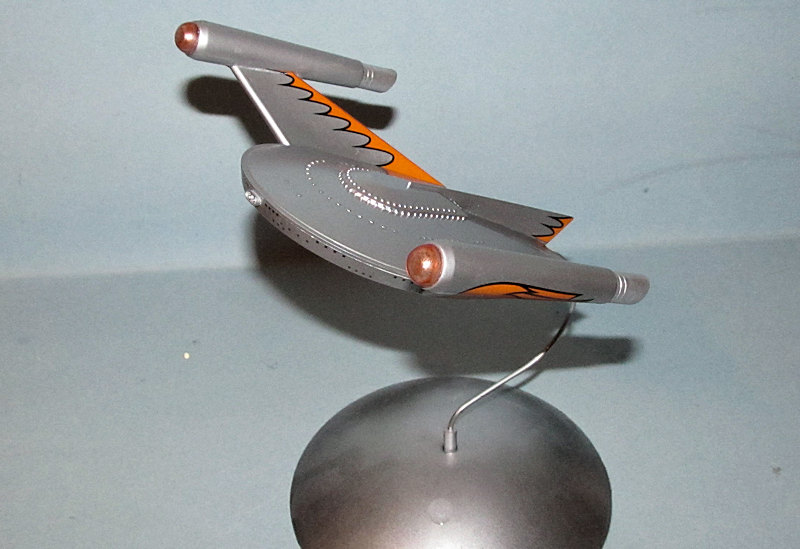
| KIT #: | 0934 |
| PRICE: | $26.00 SRP |
| DECALS: | One option |
| REVIEWER: | Dan Lee |
| NOTES: |

| HISTORY |
The Romulan Bird-of-Prey was a type of space vessel that was in service with the military of the Romulan Star Empire during the latter half of the 23rd century.
Gaining its name from the bold pattern of an alien bird's feathers painted on the ship's ventral hull, the Romulan Bird-of-Prey was the successor of a 22nd century counterpart of similar design.
The Federation Starfleet first encountered this vessel in 2266, when a single ship of this type crossed the Romulan Neutral Zone and attacked several border outposts, destroying them utterly. The USS Enterprise responded to the alert and engaged in a tense game of cat-and-mouse with the intruder for more than ten hours, before the Bird-of-Prey was destroyed. (TOS: "Balance of Terror")
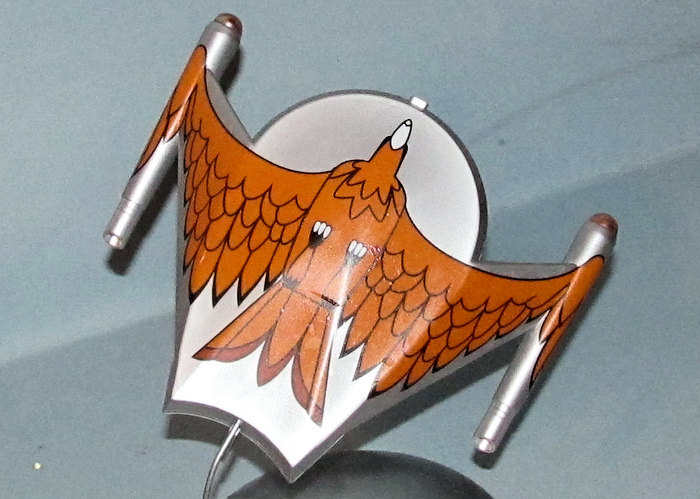 The Romulans later used larger numbers to patrol
their border with the Federation in force. Typically during an incursion, one
Bird-of-Prey would bring a starship out of warp with a plasma torpedo to allow
the ships in its battle group to attack the target en masse. When the Enterprise
violated the Neutral Zone on the orders of Commodore Stocker in 2267, it was
ambushed by a squadron of ten Birds-of-Prey. (TOS: "The Deadly Years")
The Romulans later used larger numbers to patrol
their border with the Federation in force. Typically during an incursion, one
Bird-of-Prey would bring a starship out of warp with a plasma torpedo to allow
the ships in its battle group to attack the target en masse. When the Enterprise
violated the Neutral Zone on the orders of Commodore Stocker in 2267, it was
ambushed by a squadron of ten Birds-of-Prey. (TOS: "The Deadly Years")
After the Romulan-Klingon Alliance of 2268, the Bird-of-Prey was largely supplanted by the more massive and more versatile Klingon D7-class battle cruiser, although some were used in concert with the D7s. (TOS: "The Enterprise Incident")
Remarkably similar in design to contemporaneous Federation starships, the Romulan Bird-of-Prey was designed with a sole primary hull configuration.
Originally grey in color and now metallic in the remastered episodes with its namesake bird design painted on the hull, the Bird-of-Prey was essentially a saucer with parallel warp nacelles mounted port and starboard of the main body. The aft of the ship was designed with a raised "fin." (TOS: "Balance of Terror", etc.)
Although incapable of matching the Federation's Constitution-class starship one-on-one, the ship still featured several technological advances that were previously unattainable to Federation science: the first practical invisibility screen, and the massively powerful plasma torpedo. This class of starship had a single forward torpedo launcher. It also carried a number of nuclear weapons.
The Romulan Bird of Prey model was designed and built by designer/sculptor Wah Ming Chang and measured approximately 2.5 feet in width. Built in about two weeks, Chang delivered the model to the studio unpainted. At the studio, the signature "Bird-of-Prey" graphics were applied to the model.
A full-fledged internally lit studio model, constructed out of vacuum formed plastic, plaster and metal parts, it was then sent to Linwood G. Dunn's visual effects house, Film Effects of Hollywood where the only footage of the model was shot, used in the original version of "Balance of Terror".
Stock footage from this shoot made a reappearance
in the original version of the second season episode "The Deadly Years".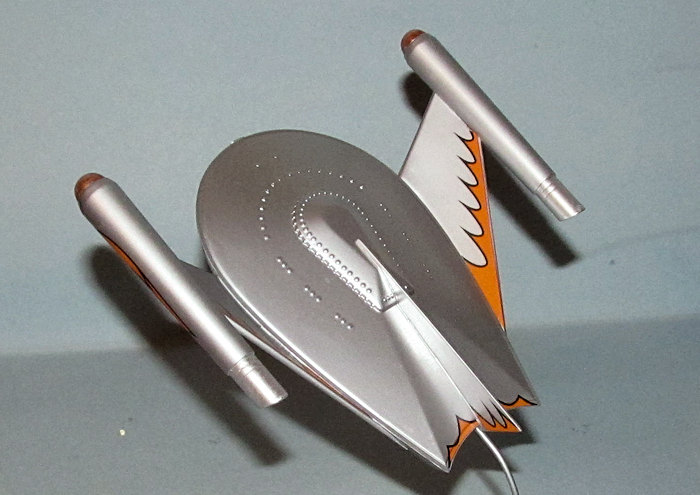
It was assumed that the original Romulan Bird-of-Prey model was lost shortly after use, either damaged, destroyed or simply disappeared, causing the D7-class model to be used in its place in the third season episode "The Enterprise Incident". (The Star Trek Compendium, 4th. ed., p. 40), It however, is concurrently also plausible that the producers wanted to showcase the new model as much as possible, among others as a courtesy to model kit company, Aluminum Model Toys – who, after all, had actually paid for the D7 model – under their exclusivity agreement, in order to give them the most exposure for their new model kit, No. S952.
The whereabouts or fate of the original Bird-of-Prey model have remained somewhat of a mystery, though there are essentially two theories about its fate in Star Trek lore. The first one is that it somehow disappeared. William S. McCullars related on his now defunct IDIC website, how he was told in 1992 by a curatorial assistant of the Smithsonian that the model was not included in their 1992 Star Trek Smithsonian Exhibit, because the private collector who held the model at that time did not want to give it up for public display.
The second theory states that the model was destroyed shortly after the episode was filmed, either by mishap on the studio lot or by Chang himself, as he himself had reportedly revealed in a 1982 National Public Radio interview. The latter resulted from a conflict with the propmaker's union. Chang as a non-member was not allowed to fabricate props for the show nor was he allowed to join. On Producer Robert Justman's urging, who considered Chang's work to be far superior to anything elsewhere available, the studio devised a ruse to make it appear that the props were bought as pre-existing and off-the-shelf from Chang and it was reflected as such in the invoices Desilu were sent by Chang (in the process also explaining why Chang never received credit for his work). This part of the problems with the union was years later, in 1996, formally confirmed by Justman in his reference book, Inside Star Trek: The Real Story (pp. 119-120). In the case of the Bird-of-Prey, however, the union got hold of evidence that the model was specifically built for the show and agreed to drop the grievance against the studio if Chang did not receive payment for the model. Without going into specifics, Justman referred to this situation when he made the short, evidently terse remark, "A year later, prior to our second season, the same union problem erupted all over again." (p. 120) Desilu gave in and returned the model unpaid to Chang, who, in a fit of anger, smashed the model to bits in his backyard with a sledgehammer. Both theories explain that the model was no longer available by the time the third season of the original series went into production.
Text from Memory Alpha (Star Trek Wiki)
| THE KIT |
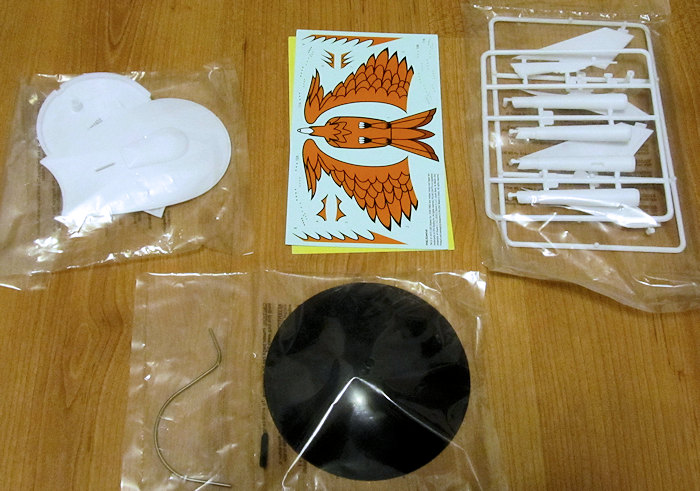 Polar Lights has produced some quite excellent
snap Star Trek kits in 1/1000 scale. This is the best one I've seen. The kit
consists of 12 parts of white plastic, 2 clear domes for the engines, one wire
frame stand and a black plastic base. The hull has a fair amount of detail on
the top. There is a bit of flash and a little warping on the nacelles in my
copy.
Polar Lights has produced some quite excellent
snap Star Trek kits in 1/1000 scale. This is the best one I've seen. The kit
consists of 12 parts of white plastic, 2 clear domes for the engines, one wire
frame stand and a black plastic base. The hull has a fair amount of detail on
the top. There is a bit of flash and a little warping on the nacelles in my
copy.
It comes with a decal sheet with an option for dark windows or outlines and a multipart bird-of-prey underside decal to make adding the decal easier.
| CONSTRUCTION |
The first thing I did was remove the nacelles and glue them together. I just used Tamiya extra thin glue for the pins and holes while I used CA glue for the seams. By gluing the parts this way I removed any need to wait several weeks for the glue to cure and eliminate the dreaded phantom seam. I also used Tamiya Grey surface filler as well. The seams were sanded smooth with various grades of wet/dry sandpaper. I did my best to eliminate the gaps inside the engine nozzles with CA glue and use of a rolled up piece of wet dry to sand it down. I thought about adding a greeble from the spares box for each nozzle but I couldn't find any that fit.
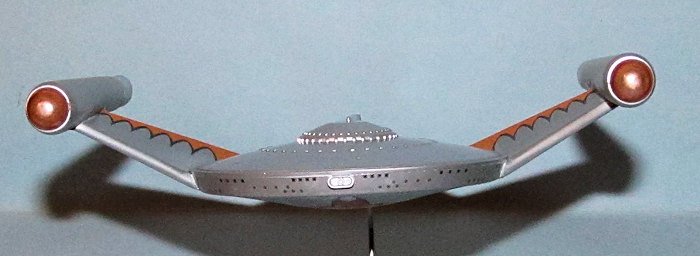 Next I assembled the wings next. I glued them
together and filled in the seams along the edges with CA glue and sanding with
increasingly finer grades of wet/dry to get a very smooth edge. I did some test
fitting into the hull and discovered to my dismay that the portside wing did not
fit very well. I had to clip off a mounting notch so that it fit the way it is
supposed to in the bottom hull.
Next I assembled the wings next. I glued them
together and filled in the seams along the edges with CA glue and sanding with
increasingly finer grades of wet/dry to get a very smooth edge. I did some test
fitting into the hull and discovered to my dismay that the portside wing did not
fit very well. I had to clip off a mounting notch so that it fit the way it is
supposed to in the bottom hull.
Finally I assembled the model. It was pretty straight forward, but there were gaps at the joins that needed to be fixed especially where the nacelles and wings met AND where the nacelles lined up with the hull. I used Vallejo plastic putty to fill those gaps and wiped away the excess with damp Q-Tips.
Now it was off to the garage for some spraying.
| COLORS & MARKINGS |
The Polar Lights marking scheme says it is supposed to be metallic silver with chrome engine nozzles. This meant Bare Metal Finish and priming. I put the model on the stand and primed it with Tamiya Grey Fine Surface Primer. Once the primer was cured, I found out to my dismay that I had some paint runs so I sanded them down before I went and used various grits of sanding/polishing cloths (from 3200 to 12000) to make sure that the surface was extra smooth. I sprayed on a second coat and repeated the sanding process till I had an extra smooth primer coat.
Once done, I sprayed on Tamiya TS-30 Polished Silver out of the can. When dry I used the same sanding/polishing cloths to smooth it out. I had some more paint runs to deal with mostly where the top and bottom coats met. I put down a second coat of Polished Silver and did the same sanding/polishing till it was ready for decals. As I waited for the 2nd coat to cure, I sprayed the inside of the clear domes with Tamiya Clear red.
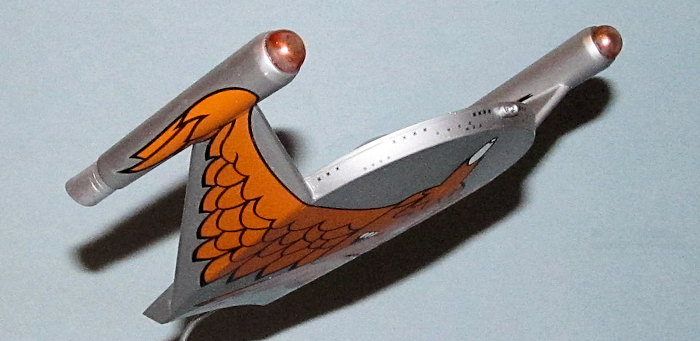 I wanted to try out some of the new Vallejo metal
colors as I got some of these new acrylic metal paints and the black primer at
the LHS. I masked of the nozzles and sprayed on the black primer with the
airbrush. It took some work to ensure I didn't get any paint runs as the primer
is very wet. I remembered to spray it down in thin coats. At this time I also
sprayed down inside of the clear domes with Vallejo white aluminum.
I wanted to try out some of the new Vallejo metal
colors as I got some of these new acrylic metal paints and the black primer at
the LHS. I masked of the nozzles and sprayed on the black primer with the
airbrush. It took some work to ensure I didn't get any paint runs as the primer
is very wet. I remembered to spray it down in thin coats. At this time I also
sprayed down inside of the clear domes with Vallejo white aluminum.
The instructions say to let it cure for 12 hours and I left it alone for a day. I wiped it down with various grades of sanding/polishing cloths before I wiped down the Bird-of-Prey nozzles to remove the paint dust and ready it for painting.
I masked off the ship and sprayed on Vallejo White Aluminum. Again, I discovered again that Vallejo is very wet paint and I ended up with paint runs as I sprayed on more than I should have. I let it dry 12 hours before wet sanding the paint runs away. The 2nd coat went on much better as I sprayed it very thin. It definitely looks different that the Tamiya Polished Silver. More chrome silver actually.
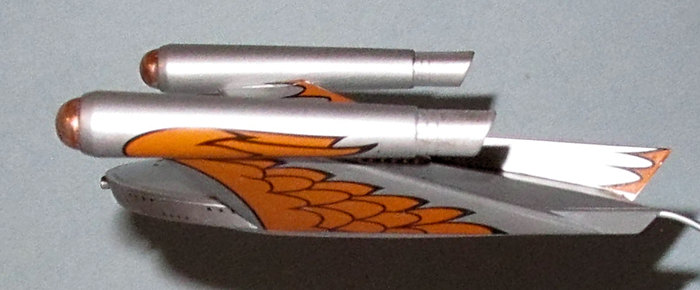 After a couple of days, I sprayed on some new
Future Polish (well, it's now Pledge) and it had a bit of a hard time grabbing
onto the metallic paint. This was something I hadn't encountered before. I had
to polish the Future coat before the decals.
After a couple of days, I sprayed on some new
Future Polish (well, it's now Pledge) and it had a bit of a hard time grabbing
onto the metallic paint. This was something I hadn't encountered before. I had
to polish the Future coat before the decals.
The Polar Lights decals weren't bad, but I found the big bird decal to be fragile as I had the edges break on me. I used Micro Sol and Set to get the decals down. Touched up the decals with black paint and light brown.
Finally, I laid down the last coat of Future. Unlike other metallic paints, the Vallejo had almost the same sheen before and after so it works as advertized.
I secured the painted engine domes to the nacelles with well placed drops of Tamiya Extra thin glue and then mounted the Bird-of-Prey to the wire stand and it was done.
| CONCLUSIONS |
The Polar Lights Bird-of-Prey is an excellent snap kit and shows how well Polar Lights has progressed since their first snap Star Trek kit, the original USS Enterprise, was released. It is definitely a fun simple model kit that can be built by modellers of all skill levels and be an excellent starter kit for those worried about the dreaded Bare Metal Finish.
23 August 2016
Copyright ModelingMadness.com
If you would like your product reviewed fairly and quickly, please contact the editor or see other details in the Note to Contributors.